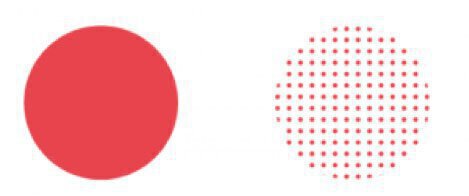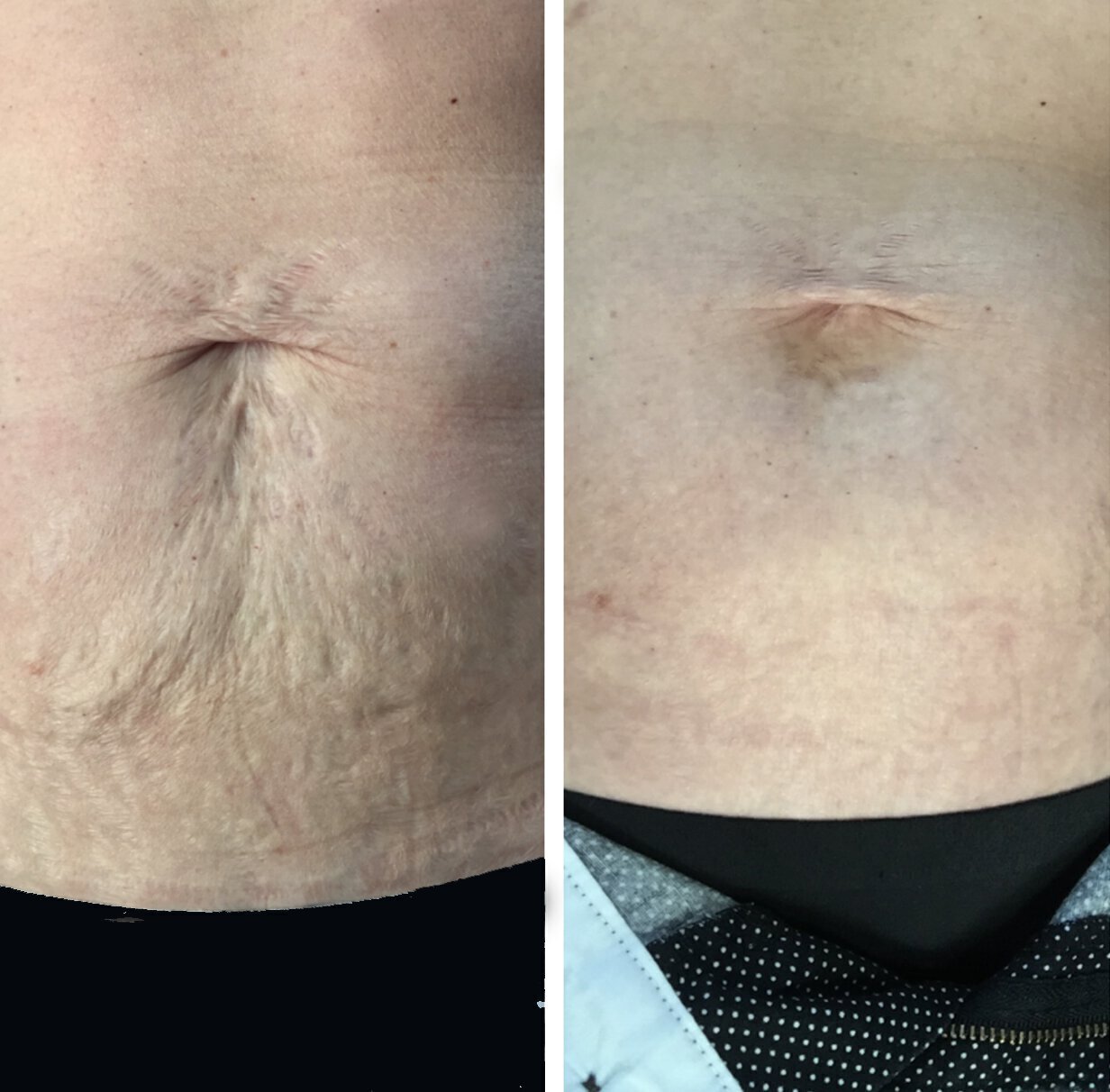








One of the true advances in laser therapy was the development of fractionated laser platforms. Fractionated laser, also known as fractional laser, is a laser system that interacts with only a percentage, or fraction, of the skin targeted. For example, a full field ablative laser will target and deliver energy to the full area that is targeted. Conversely, a fractional laser will only deliver energy to a percentage of the skin being treated. Confused yet? Imagine a sniper scope on a rifle. The entire circle of the scope represents a skin area. Full field ablative laser will deliver a laser to 100% of the target every time it is activated, but a fractional laser will only deliver a laser to a part of the target.
Figure 1 – Left sided circle represents a full field ablative laser beam. Right sided circle represents as fractional laser beam. Note that only a “fraction” of the skin is resurfaced on the right. Hence, the term fractional laser resurfacing.


As the above figure shows, fractional laser therapy delivers a “grid” of energy pulses to the skin area being treated.
These barely visible energy beams penetrate the epidermis, and pierce into the dermis at a depth decided upon by Vero Beach plastic surgeon Dr. Durkin. This treatment catalyzes your own skin to produce new, vibrant collagen that bubbles up to the surface, and your skin auto-rejuvenates over the course of days to months as fresh collagen covers your entire skin surface. So does this mean that fractional is better than full field ablative laser? The answer is yes and no. As with anything there are pros and cons to any type of laser procedure undertaken, and the comparison between full field and fractional laser therapy is no different. The primary benefit of fractionated laser therapy is that it allows Dr. Durkin to directly modulate your downtime while still producing a good skin result.
Because the fractional platform at Ocean Drive Plastic Surgery allows Dr. Durkin to direct the percentage of skin treated per pass (5.5% to 30%), and directly control the depth of penetration to within 25 microns, we can effectively predict downtime following laser therapy. As well, our laser allows us to separately deliver coagulative energy and ablative energy, meaning that we can tailor the laser effect to an individual’s skin type. Because of the ability to tailor the laser therapy to each individual patient, laser patients at Ocean Drive Plastic Surgery are given the option on how long they can afford to be away from work, travel, vacation, etc.
This gives an incredible sense of safety and comfort to our laser clients, as they know that their overall life schedule will not be proverbially “thrown out of whack” because of their investment in their appearance. Downtime following fractional laser therapy can be tailored between 2 days to 12 days, depending on how much result you want from your initial treatment, and how much time you can spend on recovery. Most of our Vero Beach fractional laser therapy patients have very busy social or work schedule, and only have a few days or a weekend to recover. The other major advantage of fractional laser therapy is that the chances of hyperpigmentation and hypopigmentation are markedly reduced as compared to full field ablative laser.
This allows fractional laser to be used in women with olive, and deeper toned skin, making this procedure as popular amongst Asian, Hispanic, and Indian men and women as it is with Caucasian patients. This laser platform has been used safely in Fitzpatrick skin types I-IV without scarring or pigmentation changes. Comparatively, full field ablative lasers very commonly produce pigmentation changes when used on patients who have deeper skin tones. The last, and without question, the most important benefit of fractionated laser therapy is its ability to induce the formation of new, healthy, type I collagen in the epidermis and dermis. Use of laser therapy is a direct investment in your skin quality. Patients will immediately see and feel a tightening of their skin, a reduction in pore size, and an improvement of texture throughout their face.
Skin will feel softer, and look younger within days of treatment. However, the benefits of this therapy are far longer lasting than just the initial outcome. Over the course of months, the dermis will continue to produce new, healthy, organized collagen, leading to a marked reduction in the appearance of aging.
As such, the best results that we see with fractionated laser are in those patients who undertake a series of these treatments, rather than those who only receive one session. By spacing out treatments over months to years, patients can maintain a youthful skin quality as they age. With fractional laser, your result per treatment is directly proportionate to how much downtime you can afford. Full field ablative laser patients tend to undertake one treatment every 10-15 years, while many fractional patients receive ongoing treatment annually to maintain their skin quality.
As comparison, a series of three fractional laser treatments traditionally produces around 70-75% of a full field ablative laser result with downtime after therapy decided upon by the patient’s schedule over time. Conversely, full field ablative laser treatments are best for patients who are willing to accept a “twilight” anesthetic, and want one treatment that will last years but require 1-2 weeks of downtime. Fractional laser treatments, on the other hand, are best suited for patients who want to incrementally improve and maintain their appearance without significant downtime, but are more amenable to ongoing therapy.
Fractional laser therapy is routinely applied to patients of all ages (25-70 years old) who want to comprehensively improve and/or maintain their appearance over time. Interestingly, men undertake fractionated laser therapy just as often as women at Ocean Drive Plastic Surgery. The procedure primarily targets texture problems, like fine lines and wrinkles, rough skin texture, enlarged pore size, and toneless flat-appearing skin.
Patients typically receive a series of treatments until their desired result is achieved. Subsequently, maintenance treatments should be undertaken, with the best results being seen by patients undertaking annual boosting treatments. While it does improve brown spots and pigmented lesions, it is not as effective in treating these issues as broad-band light therapy, and other laser therapies. Fractional laser is often combined with Botox, dermal filler therapy, Kybella, as well as with invasive therapies, such as facelift, eyelid surgery, and others. Most patients request a downtime between 2-7 days, with patients receiving more energy leaning towards more dramatic results with longer recovery.
Our most common fractional laser patient will undertake a series of two to three moderate depth fractional laser treatments, each having a 2-3 day downtime. Fractional laser treatments do not require any IV anesthesia or sedation. Patients receive topical numbing with a compounded BMT cream, and comfort is maximized with a Zimmer chiller. The procedure takes approximately 45 minutes, and is well tolerated by men and women of all ages. Following their treatment, our Vero Beach fractional laser patients apply a series of hydrating creams designed to maximize result, and minimize downtime. There are no restrictions on exercise, physical activity, or showering. Most patients, as stated above, use fractional laser therapy in an incremental way to maximize their long term result without the need for prolonged downtime.

Fractional laser therapy is one of the best-kept skin maintenance secrets for men and women. In our practice, our best skin results are clearly seen with patients who maintain fractional laser therapy on at least an annual basis to keep skin soft, elastic, and glowing. Because we can tailor downtime, this modality is routinely used for the finest in skin maintenance. This type of therapy is especially popular amongst 35-50 year old patients who want to prevent problems before they occur. For older patients who present with skin issues, we employ fractional therapy until we achieve our desired result, and then set patients up on an annual maintenance schedule.
Fractional laser therapy is also the gold standard therapy for acne pitting and scarring. Our patients with acne scarring are typically treated with a series of three to five fractional laser sessions. A balance of coagulative and ablative depths are always used in these patients in the attempt to create a smoother skin texture. Lastly, fractional laser therapy is, in our opinion, the best available skin maintenance following facelift or eyelid surgery. We strongly encourage all of our facelift patients to undertake fractionated laser therapy moving forward to support their skin tone and maintain their facelift result by continually improving their skin collagen.

At Ocean Drive Plastic Surgery in Vero Beach, Dr. Alan Durkin and their team of providers deliver incredible results tailored to your needs in a relaxing and uplifting atmosphere. Learn more about the Ocean Drive difference by scheduling your one-on-one diagnostic consultation with Dr. Durkin today.